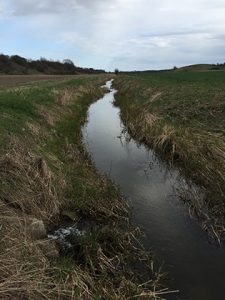In this post, we talk about our recently published paper “Exposure pathway-dependent effects of the fungicide epoxiconazole on a decomposer-detritivore system”.

A stream section surrounded by agriculture in southern Sweden (photo by: A. Feckler)
Fungicides that enter aquatic ecosystems can affect macroinvertebrate leaf shredders via two pathways: first, by direct exposure over the water phase and co-ingestion of fungicides sorbed to leaf material. Second, fungicides may indirectly affect leaf shredders by inhibiting the colonization of leaf material by fungal decomposers on which the leaf shredders’ nutrition heavily relies. Independent of the pathway, effects on leaf shredders may induce subsequent implications on energy provisioning in aquatic ecosystems. Fungicidal effects via the indirect pathway, however, have so far only been studied for rather sensitive leaf shredders like Gammarus fossarum (see related posts “You are what you eat” and “You are what you eat – continued”). Although sensitive species can be highly abundant in undisturbed streams, they can be rarely found in agriculturally influenced stretches of streams. There, more tolerant leaf shredders like Asellus aquaticus might become predominant and take over the function of leaf breakdown.
To address and disentangle the biological relevance of the different exposure pathways for an anticipated tolerant leaf shredder, we conducted a 24-d-lasting experiment with the crustacean A. aquaticus applying the fungicide epoxiconazole at 15 µg/L in a 2×2-factorial design (see illustrative scheme here).
Our observations showed that both exposure pathways led to changes in asselids’ assimilation (i.e., the difference between consumption and excretion), growth, and physiological fitness (judged by animals’ lipid content and fatty acid composition). Thereby, the direct exposure pathway generally caused stronger effects. Furthermore, when applied in combination, the exposure pathways acted additively. These results showed that the applied fungicide can cause complex effects on the function and fitness of the relatively tolerant A. aquaticus and hence the energy provisioning in impacted streams. This may influence other invertebrates due to a reduced production of fine particulate organic matter. On the other hand, since leaf shredders themselves represent a source of fatty acids, nutrients, and carbon from the base of the food web to higher trophic levels, effects for predatory organisms are conceivable.
The paper was authored by Alexander Feckler, Willem Goedkoop, Jochen Zubrod, Ralf Schulz, and Mirco Bundschuh and published in Science of the Total Environment.
